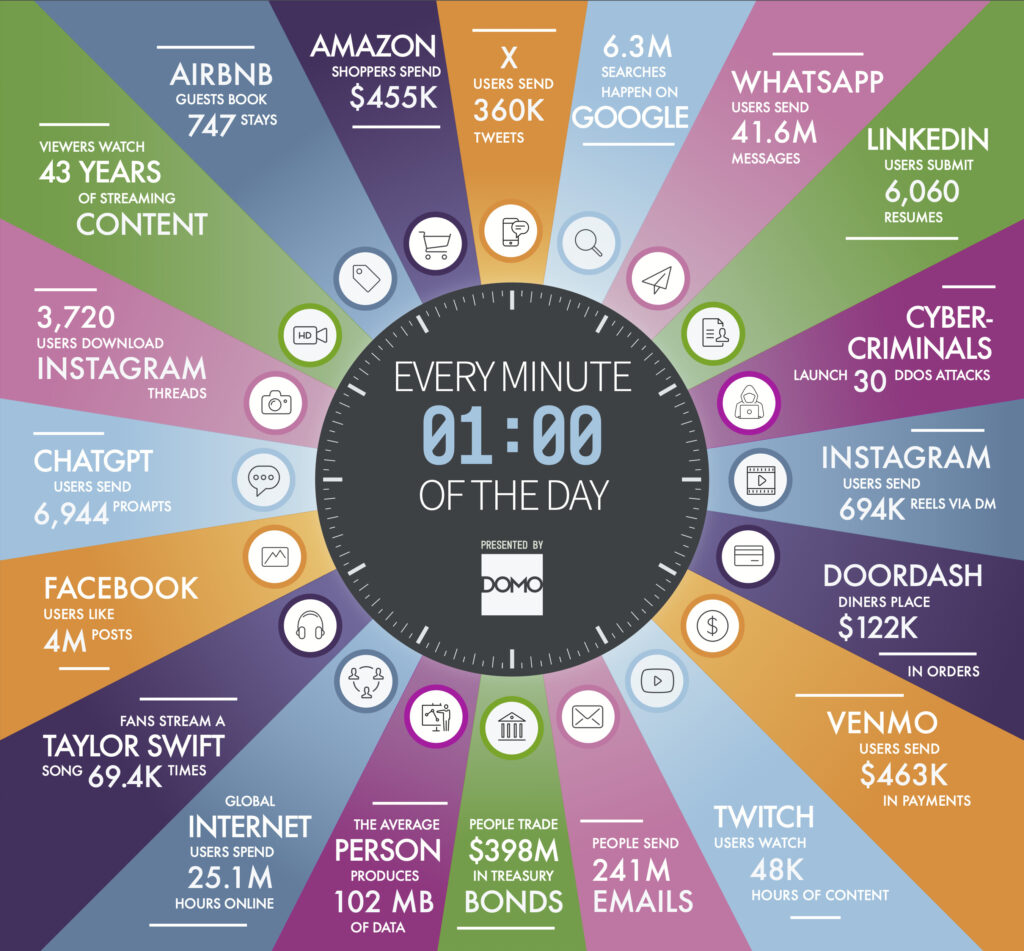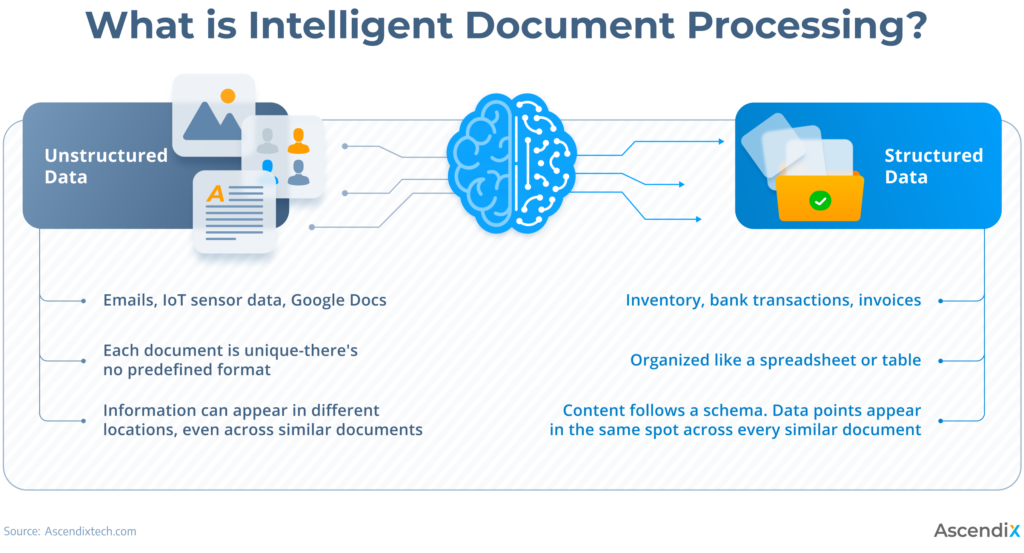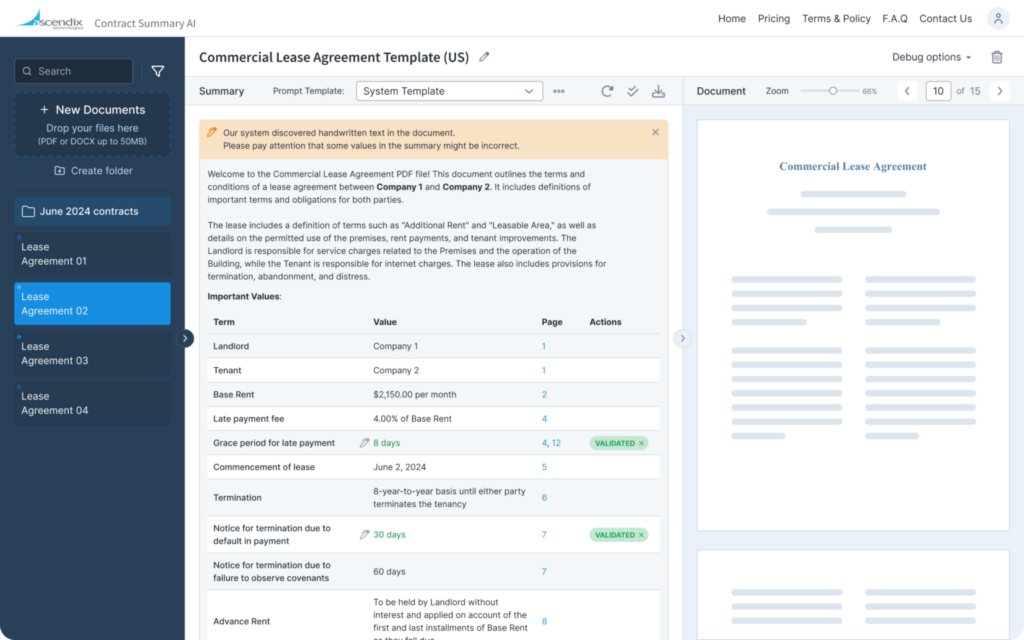Automate Your Real Estate Document Processing
Ascendix has built an AI framework specifically trained to abstract, summarize and unlock insights from real estate documents.
According to different estimates, at least 80% of data in the world is unstructured. Imagine how many powerful insights lie beyond the database tables in scanned documents, handwritten text, video, audio, webpages, emails, surveys, etc.
But how to deal with unstructured data? Can AI analyze unstructured data? How to avoid the risks unstructured data causes? We will answer all those questions, but let’s start with the most important one: what is unstructured data?
Unstructured data is information that does not have a clear structure and default format or organization. Simply put, unstructured data can’t be fit into a table, sorted into rows and columns, or labeled. That’s why unstructured data management and analytics are challenging and resource-consuming since machines cannot fully understand or categorize them.
All those types of unstructured data can be sorted into human-generated and machine-generated.
| Human-generated unstructured data | Machine-generated unstructured data |
|---|---|
| -Text data (social media posts, emails, blog posts, books, articles, and other written content); -Audio data (voice recordings, voicemail messages, podcasts); -Image data (photographs, drawings and illustrations, infographics, memes); -User Interactions (web browsing history, search engine queries). | -Log files; -Sensor data (IoT sensor data, satellite imagery, and telemetry data); -Network traffic data (network packet captures, firewall logs, VPN logs, Network flow data); -Multimedia data (CCTV camera footage); -Scientific Data (particle physics experiment data, astronomical observatory data). |
Big data implies a massive volume of structured, semi-structured, and unstructured data. Unstructured data holds 80% of big data. To better understand the scale of unstructured big data, consider that more than 50% of enterprises manage at least 5PB of data (5 x 1,024 terabytes), and this amount is growing relentlessly. Data Never Sleeps has shown its latest research results, and the numbers are overwhelming.

Data Never Sleeps Research 2023
Unstructured big data sounds distant and out-of-touch now, but look at how full your cloud storage is, how thick your photo albums and yearbooks are, and how often you accept cookies on every website you visit. Those are only a few examples of unstructured data around you. What about whole industries?
Real estate makes a tremendous contribution to the rapid accumulation of unstructured data in big data. For example, Zillow alone receives around 40,000 listings monthly, filled with text, visual, and video content. That’s a tremendous amount of unstructured data that keeps growing.
Business documents have the lion’s share among the examples of unstructured data in real estate. Real estate is one of the most paper-heavy industries, alongside finance and healthcare. That’s why unstructured data management has been a long-standing problem here.
A survey of more than 300 IT leaders shows that nearly 68% of them spend over 30% of their budget on data storage, management, and protection. Intelligent Data Processing, using the latest AI technologies, can lighten this financial burden and convert unstructured data into partially structured data.

Let’s see how it works using the example of a complex framework we built at Ascendix for IDP.
Still can’t see the big picture? Let’s break down the process of creating a lease abstract with the help of AI. Commercial lease agreements are among the longest and most complex documents in real estate. An AI lease abstraction tool can transform tons of pages of unstructured data into an organized summary and save up to 25% of the time spent on commercial lease agreement processing. Extracted structured data are presented as neat tables, which are easier to comprehend and more efficient to store.

Interface of AI Lease Abstraction Tool | AscendixTech
Ascendix’s robust framework can help optimize unstructured data processing. Use AI to extract valuable data from a sea of files, abstract complex documents into concise summaries, process data from scanned and handwritten documents, categorize them effortlessly and make the most of unstructured data.
Ascendix has built an AI framework specifically trained to abstract, summarize and unlock insights from real estate documents.
Unstructured data management covers the processing, collecting, storage, and analysis of unstructured data. Since unstructured data are not presented in a pre-defined format and usually do not have a straightforward structure, all related processes are associated with challenges. Unstructured data is something in between a Pandora’s box and a treasure chest—it can have both benefits and risks.
The potential risks of unstructured data in real estate, if not managed effectively, can result in:
In contrast, efficient unstructured data management with AI tools will significantly enhance:
The list of risks and opportunities does not end here, so do not hesitate to open this mystery box called unstructured data with the help of AI and a trustworthy partner.
Ascendix has been an industry leader since 1996 and has earned the trust of JLL and Savills, as well as over 300 other clients worldwide. Over the years, we have gained a breadth of experience in property technology development, AI integration, AI-powered solution creation, and business automation.
We’ve developed our own document abstraction framework tailored specifically for real estate businesses. This framework can become a solid basis for your custom solution, and it is faster and cheaper than beginning from scratch. Also, the solution built on Ascendix’s real estate industry-focused framework will surpass any generic tool implementation or customization.
Do you have an exciting idea? Contact us to discuss its realization and further integration with your company software.
Already have an AI tool integrated? We can audit the system and suggest improvements.
Intelligent Document Processing can optimize your business processes weighed down with terabytes of unstructured data. Schedule a free consultation, and our experts will help you choose a suitable AI solution.
Any type of information that cannot be transformed into a table because of its lack of structure and organization is considered unstructured data. Images, emails, social media, videos, search history, GPS data, books, property descriptions, PDFs, and scanned documents are perfect examples of unstructured data.
Books, audio, video, images, data about user interactions, cash, cookies, and social media are examples of unstructured data in everyday life. Focusing on the real estate industry, examples of unstructured data are property listings, contracts, floor plans, and 3D tours, clients’ feedback and reviews, etc.
Unstructured data cannot be labeled or sorted into rows and columns, so machines have difficulty understanding and analyzing it. Also, it’s difficult to optimize unstructured data for charts and diagrams or any other visual representations.
Kateryna is passionate about exploring proptech technology trends and innovative solutions for real estate. In her articles, she dives into the world of proptech to share industry news and insights to help modernize real estate workflows.
Get our fresh posts and news about Ascendix Tech right to your inbox.